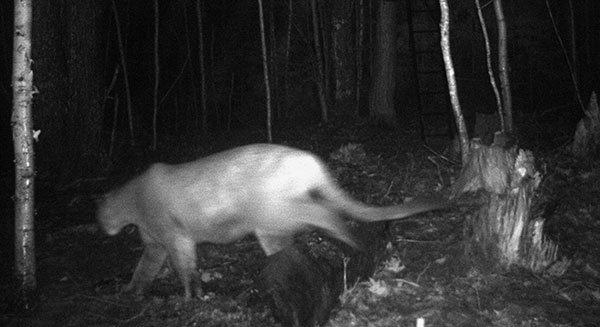(Provided by Michigan DNR)
*Click the small image for a larger view*
 Three recent trail camera photos of cougars in the Upper Peninsula have been verified by the Michigan Department of Natural Resources.Trail camera photo of cougar verified by Michigan DNR
Three recent trail camera photos of cougars in the Upper Peninsula have been verified by the Michigan Department of Natural Resources.Trail camera photo of cougar verified by Michigan DNR
Two of the photos, both of a cougar with a radio collar, were taken in October in Menominee County one near Cedar River and one near Menominee just north of the Wisconsin border.
The third photo was taken in northern Marquette County in November. The cougar in the Marquette County photo is not wearing a radio collar.
The DNR does not place radio collars on cougars; North Dakota and South Dakota are the nearest states where wildlife researchers have placed radio collars on cougars to track their movement. The DNR has not yet been able to determine the origin of the radio-collared cougar that is in Michigan.
In the fall of 2011, a radio-collared cougar was photographed in Ontonagon, Houghton and Keweenaw counties. Although the cougar recently photographed in Menominee County is wearing the same type of radio collar, DNR wildlife biologists are currently unable to determine whether this is the same animal or another transient that has dispersed from western states.
All three photos were taken by trail cameras located on private property and the landowners have asked to remain anonymous. DNR Wildlife Division staff members were able to visit each location to confirm the authenticity of the photos.
DNR Wildlife Division staff has now verified the presence of cougars in the Upper Peninsula 20 times since 2008.
To date, the DNR has confirmed 11 photos, eight separate sets of tracks, and one trail camera video from 10 Upper Peninsula counties: Baraga, Chippewa, Delta, Houghton, Keweenaw, Mackinac, Marquette, Menominee, Ontonagon and Schoolcraft.
The increasing number and frequency of verified cougar sightings in recent years are likely due to three factors in particular: The growing popularity of trail cameras used to monitor wildlife activity in the woods 24 hours a day; additional transient cougars moving east from established populations in western states as they seek new territory; and the cooperation of the public in reporting cougar sightings and sharing their photos with us for official review, which we greatly appreciate, said Adam Bump, one of four DNR biologists specially trained to investigate cougar reports.
Established cougar populations are found as close to Michigan as the Dakotas, and transient cougars dispersing from these areas have been known to travel hundreds of miles in search of new territory. DNA evidence collected from a cougar hit and killed by a car in Connecticut in 2011 showed it had originated in western South Dakota.
Cougars, also known as mountain lions, were native to Michigan, but disappeared from the state in the early 1900s. The last confirmed wild cougar in Michigan prior to 2008 was an animal killed near Newberry in 1906.


